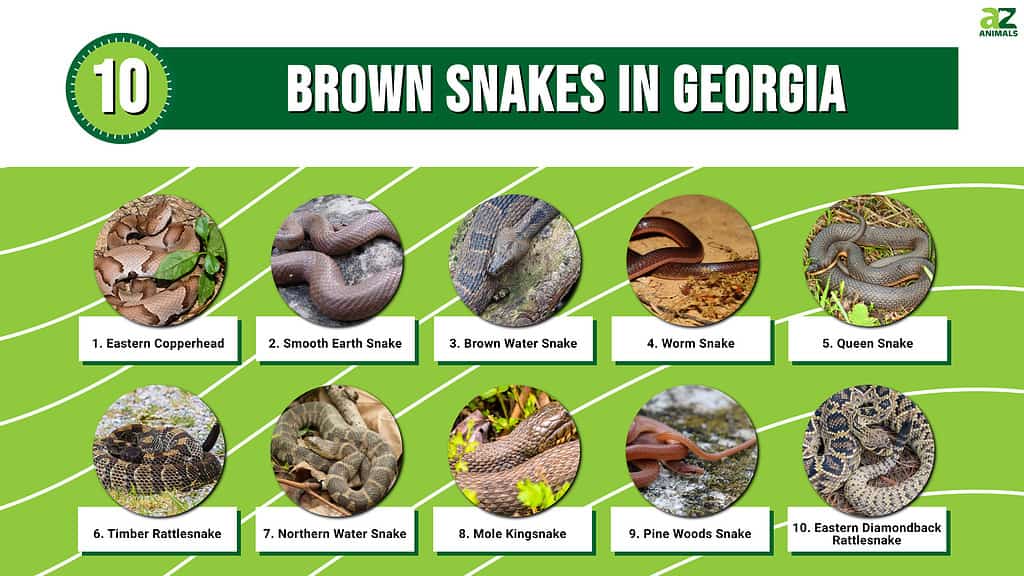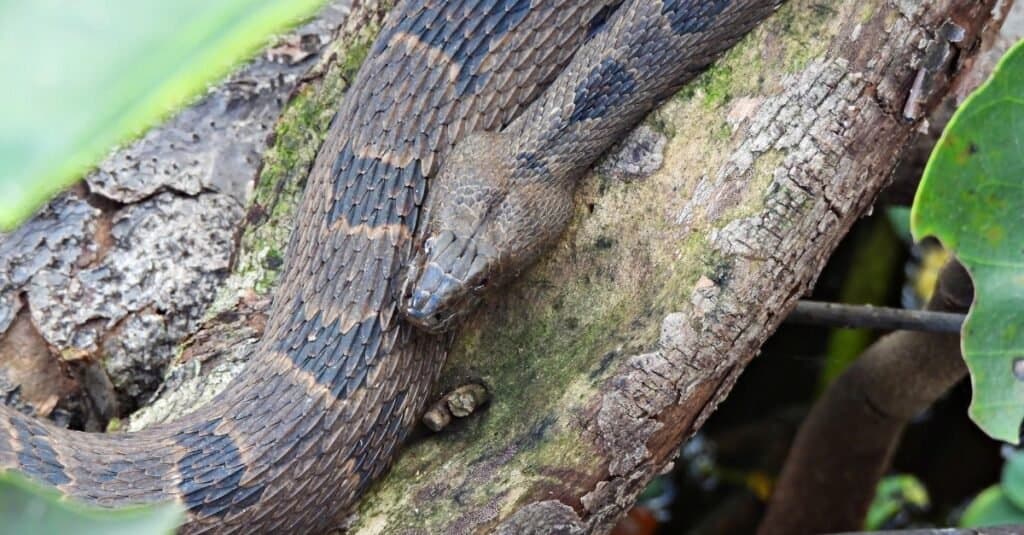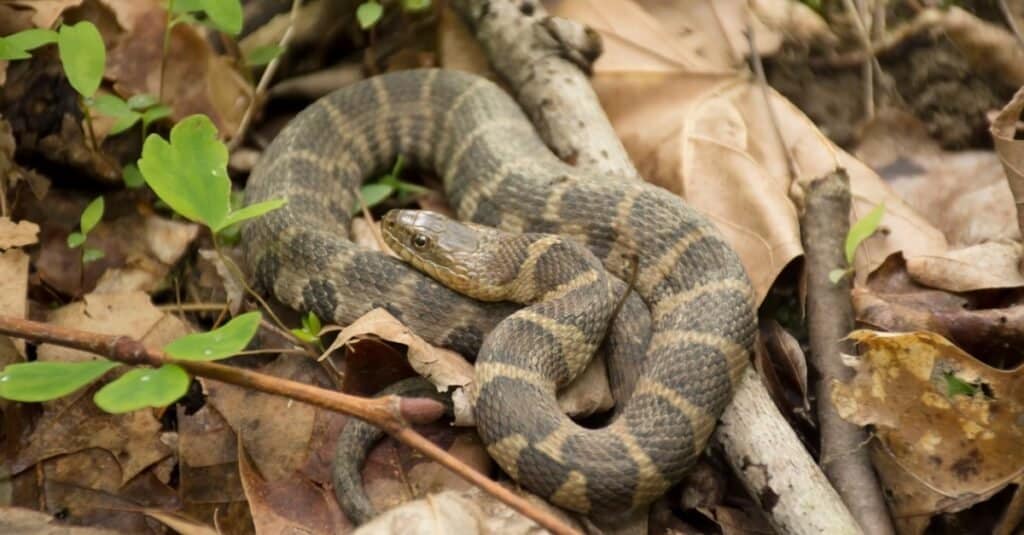Spanning a vast 57,000 square miles, Georgia has an array of habitats that are home to many wonderful animals.
With miles of coastline, stunning mountains, and acres of farmland, there are many rich and diverse ecosystems. Some of the most abundant animals to call Georgia home are snakes. There are 46 species of snake in the state, including six that are venomous.
Although many snakes are brightly colored and have many stunning patterns, some use their color to help them to blend in with their surroundings. In fact, some of the best-camouflaged snakes are brown snakes, as they are difficult to spot amongst logs and leaf litter.
So, join us as we discover some of the brown snakes in Georgia!

1. Eastern Copperhead

Eastern copperheads are venomous snakes that have large brown blotches over a pinkish-tan base color.
©Jeff W. Jarrett/Shutterstock.com
The first snake on the list is the venomous eastern copperhead. Eastern copperheads are 22 to 36 inches long and have heavy bodies which are a pale, pinkish-tan color and covered with tan or brown crossband markings. Their preferred habitats are deciduous forests and mixed woodlands – often bordering low-lying swamp regions.
These snakes are nocturnal during the summer months and diurnal during the spring and fall. However, they typically hibernate during the winter in dens or crevices with rat snakes and timber rattlesnakes. Eastern copperheads have a mixed diet of invertebrates, lizards, rodents, birds, and other snakes.
Although they are venomous, studies have found that their venom is the weakest of all the pit vipers. Also, rather than attacking outright, eastern copperheads tend to do a “warning bite” first, which injects little to no venom.
2. Smooth Earth Snake

Smooth earth snakes are small brown snakes that like to hide away in leaf litter.
©Matt Jeppson/Shutterstock.com
As small, non-venomous snakes, smooth earth snakes are only 7 to 10 inches long. They are almost entirely brown but have small black rings around their eyes and small dark spots on their backs. They also have pointed snouts and white on the underside of their head.
Smooth earth snakes are typically found in forest habitats where they can hide away underneath rocks, logs, and leaf litter. Females usually give birth in August to around ten tiny juveniles, which are only 2.5 inches long. Smooth earth snakes mainly eat earthworms, slugs, and snails.
3. Brown Water Snake

Brown water snakes are large brown snakes with around 25 black markings down their back.
©iStock.com/passion4nature
One of the most common brown snakes in Georgia is the brown water snake which lives in rivers and streams all over the southeastern United States.
Brown water snakes are typically 30 to 60 inches long, although longer specimens are not uncommon. They have brown bodies with around 25 black or brown markings down their back. Given their appearance and habitat, they are often mistaken for venomous cottonmouths.
However, despite having large bodies, brown water snakes have a neck that is significantly narrower than their head which is usually their most distinguishable feature. These snakes feed mainly on small fish, with young catfish being particularly favored. Although they are not venomous, brown water snakes can be aggressive when threatened, and bites can be painful.
4. Worm Snake

Worm snakes typically have dark tops and lighter-colored undersides.
©Jason Patrick Ross/Shutterstock.com
One of the smaller brown snakes in Georgia is the worm snake, which is brown on the dorsal side and either pink or orange on the underside. Worm snakes reach lengths of up to 14 inches and have narrow heads with small eyes.
They are particularly shy and secretive, which makes them difficult to spot, as they spend much of their time hiding away in leaf litter or buried in loose soil. Worm snakes are not venomous, and they eat earthworms and slugs.
As they are so small, they have many predators – including venomous coral snakes.
5. Queen Snake

The queen snake is a non-aggressive, non-venomous snake found in North America.
©Jason Patrick Ross/Shutterstock.com
A small semi-aquatic snake is the queen snake which rarely ever exceeds 24 inches long. Queen snakes are dark brown to gray, with yellowish bellies and faint yellowish stripes running down their bodies, giving them a similar appearance to garter snakes.
These snakes have narrow heads with thick scales both on the top and underneath their chins – a unique adaptation that provides protection when they chase their prey underneath rocks. Their habitat is always in and around rocky-bottomed streams.
Queen snakes prey almost exclusively on freshwater crayfish, which they detect using only their sense of smell.
6. Timber Rattlesnake

Timber rattlesnakes are brown with darker crossband markings providing excellent camouflage in forests.
©Frode Jacobsen/Shutterstock.com
Another venomous brown snake in Georgia is the timber rattlesnake, which is endemic to the eastern area of North America. Timber rattlesnakes are between 36 and 60 inches long and have thick, heavy bodies which are brown with black or brown crossband markings. They live in a variety of habitats but typically prefer deciduous forests.
However, pregnant females tend to prefer areas with a higher temperature – such as open, rocky ledges. Timber rattlesnakes feed mainly on birds, rodents, frogs, and other snakes (particularly garter snakes). Although they don’t have a particularly aggressive nature and prefer to flee in the presence of a threat, timber rattlesnakes are highly venomous.
These snakes possess a high amount of venom as well as incredibly long fangs with which to inject it.
7. Northern Water Snake

The northern water snake has a flat head that is as wide as its neck.
©iStock.com/IcemanJ
Also known as common water snakes, northern water snakes are widespread and completely harmless. They are large snakes and can reach almost 4.5 feet long, with females being larger than males. These snakes are brown or brownish-black with dark crossbands and blotches. Their appearance often leads to them being mistaken for venomous cottonmouths, and as a result, many are wrongly killed.
Northern water snakes live near permanent water sources, such as rivers, streams, ponds, and swamps.
They spend much of their day basking on rocks and logs but flee into the water at the first sign of danger. Northern water snakes hunt near the edge of the water and in the shallows and prey on fish, frogs, salamanders, lizards, birds, and other small mammals.
8. Mole Kingsnake

Mole kingsnakes are snakes that typically inhabit grasslands.
©Krumpelman Photography/Shutterstock.com
Another non-venomous snake is the mole kingsnake which reaches 30 to 40 inches long. Mole kingsnakes are light brown or gray with large brown blotches down their bodies. Due to their appearance, they are often mistaken for rat snakes which often look similar. Mole kingsnakes prefer to live in open grasslands close to forest edges and a permanent water source.
When threatened, they typically vibrate their tail in the leaf litter, which creates a warning buzzing or rattling sound, although they are not rattlesnakes. Mole king snakes mainly eat rodents, which means they are actually beneficial, as they keep rodent populations in check.
9. Pine Woods Snake

Pine woods snakes are small and secretive snakes that live in woodlands.
©Andrew Jeffries/Shutterstock.com
One of the most secretive snakes is the pine woods snake which inhabits pine forests and damp woodlands where it typically hides underneath leaves and rotten logs. At only 10 to 13 inches long, pine woods snakes are also one of the smallest snakes in Georgia.
They are a reddish-brown to reddish-orange color, with a lighter stripe down their back. Pine woods snakes are nocturnal and feed on frogs, lizards, and salamanders. Although they are mildly venomous to their prey, they are not dangerous to humans.
10. Eastern Diamondback Rattlesnake

Eastern diamondback rattlesnakes have a pattern that often fades towards their tail.
©Chase D’animulls/Shutterstock.com
The final brown snake in Georgia on the list is the largest species of rattlesnake in the world – the eastern diamondback rattlesnake. Although eastern diamondback rattlesnakes are typically between 3 and 6 feet long, a record of 9ft 3in has been recorded.
These snakes have heavy, brownish bodies which are overlaid with stunning diamond markings that have dark brown centers and cream borders. They live in pine forests, sandhills, cypress swamps, and saltmarshes.
They also regularly live in gopher tortoise burrows during both the summer and winter. Eastern diamondbacks are excellent swimmers and have been spotted swimming between barrier islands and occasionally miles out to sea.
They can strike from a distance of four feet away and prey on rabbits, rodents, and birds.
Summary of 10 Brown Snakes in Georgia
| Rank | Snake |
|---|---|
| 1 | Eastern Copperhead |
| 2 | Smooth Earth Snake |
| 3 | Brown Water Snake |
| 4 | Worm Snake |
| 5 | Queen Snake |
| 6 | Timber Rattlesnake |
| 7 | Northern Water Snake |
| 8 | Mole Kingsnake |
| 9 | Pine Woods Snake |
| 10 | Eastern Diamondback Rattlesnake |
Five Facts about Snakes
- The two fangs of venomous snakes are hollow. These are used to inject venom into their victims.
- A snake’s jaw is extremely flexible, allowing it to eat big prey.
- Snakes only eat live prey, and they swallow it whole. No chewing!
- Snakes use their tongues to taste scents in the air.
- Venomous snakes kill over 100,000 people every year.
The photo featured at the top of this post is © Chase D'animulls/Shutterstock.com
Discover the "Monster" Snake 5X Bigger than an Anaconda
Every day A-Z Animals sends out some of the most incredible facts in the world from our free newsletter. Want to discover the 10 most beautiful snakes in the world, a "snake island" where you're never more than 3 feet from danger, or a "monster" snake 5X larger than an anaconda? Then sign up right now and you'll start receiving our daily newsletter absolutely free.
Thank you for reading! Have some feedback for us? Contact the AZ Animals editorial team.






